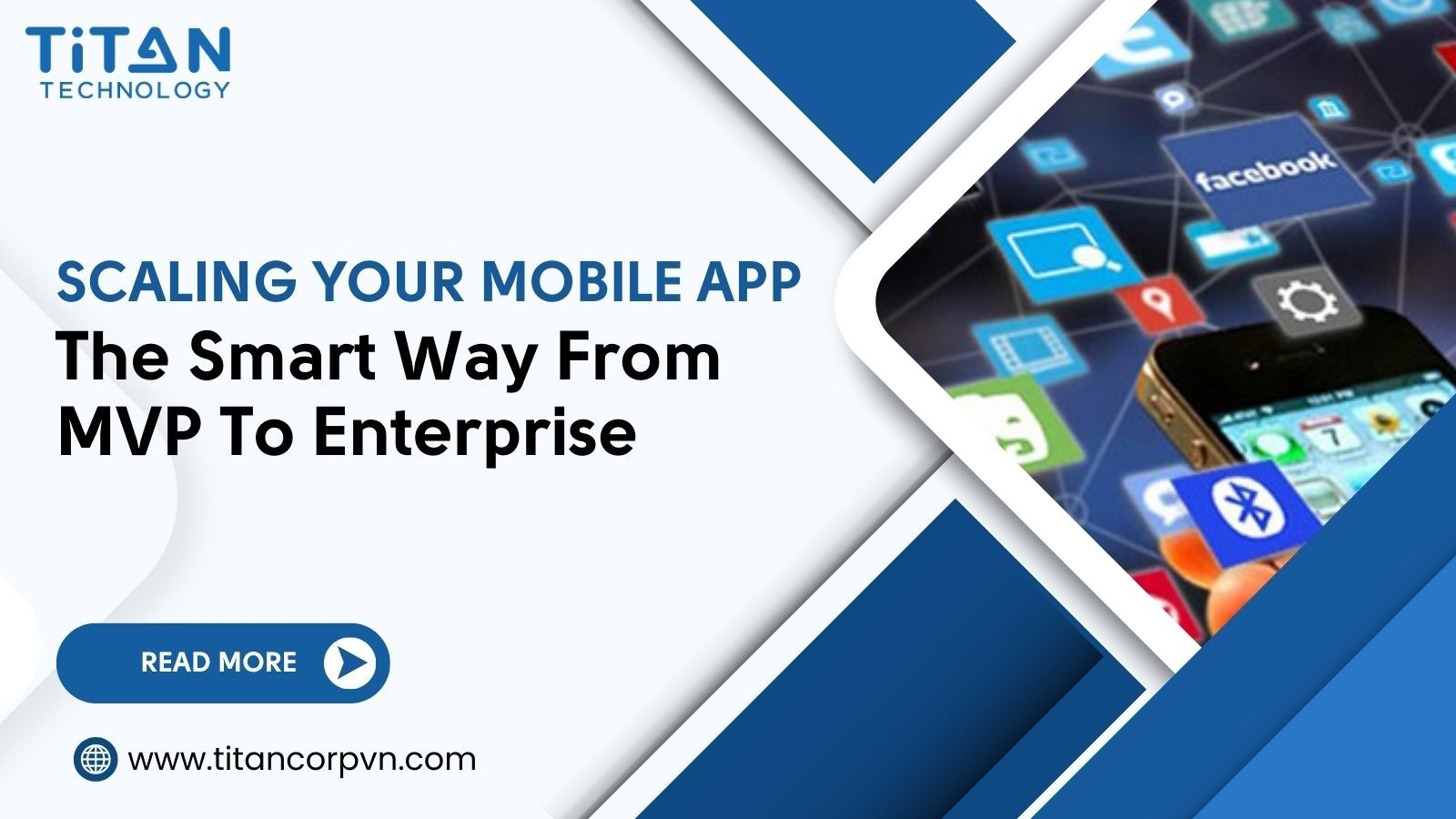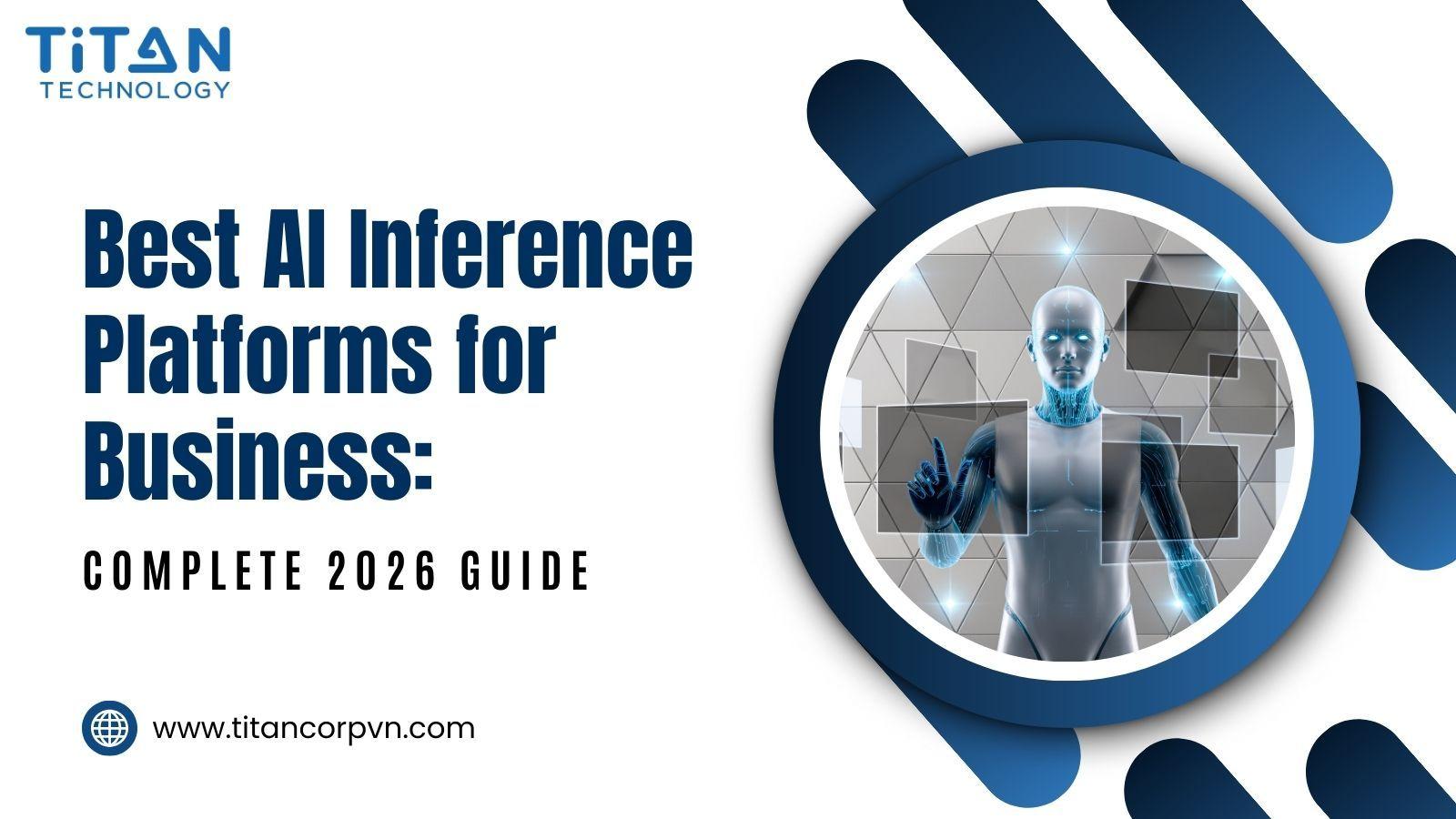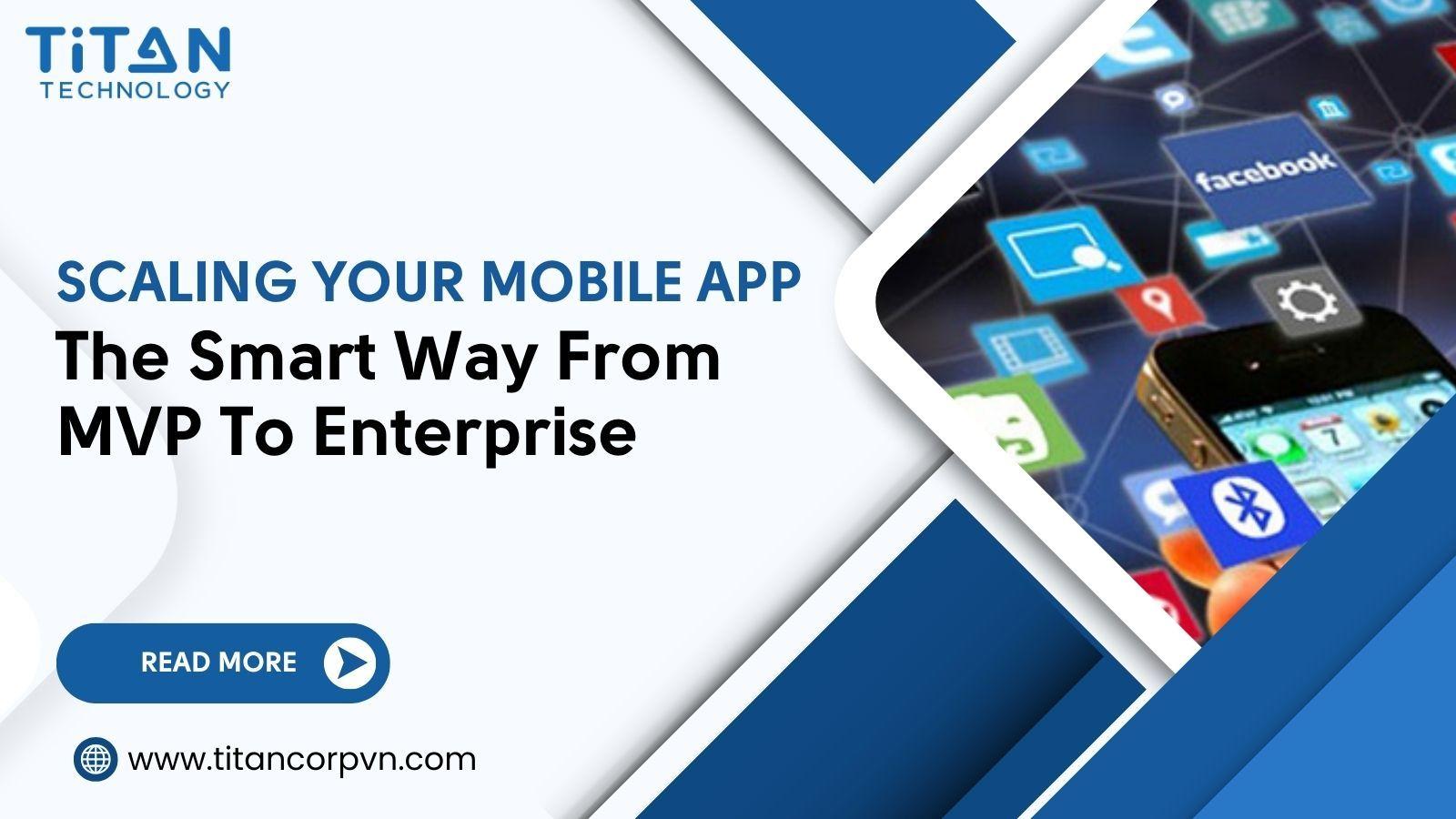Summary:
The article explains the full journey of scaling a mobile app from MVP to an enterprise-grade product.
It highlights the role of an MVP in launching quickly, validating ideas, and reducing initial risk.
It emphasizes the importance of beta testing for identifying issues early, enhancing user experience, and validating product-market fit.
It outlines what is required when scaling an app: performance optimization, stronger security, CI/CD implementation, and enhanced UX.
It discusses how outsourcing supports faster delivery, flexible scaling, and reduced operational burden.
It shows how a trusted development partner can guide businesses from MVP creation to large-scale deployment.

The mobile application market is exploding. In 2025, global mobile app revenue is forecasted to reach $613 billion, fueled by skyrocketing smartphone usage and demand for mobile-first digital services, as outlined by DesignRush. According to Statista, app downloads are expected to exceed 300 billion, underscoring the dominance of mobile in both consumer and enterprise markets.
This explosive growth offers immense opportunities—but also significant challenges—for businesses seeking to scale their digital products. Moving from a Minimum Viable Product (MVP) to a fully scalable, enterprise-grade mobile application requires addressing complex issues, including architectural scalability, user experience optimization, security, and rapid feature delivery.
The mobile app outsourcing market has become a key enabler of this transition. The global IT outsourcing industry is forecasted to reach $1,149.24 billion by 2032, growing at a CAGR of 8.2%, according to research conducted by Precedence. This momentum is driven by the need for faster innovation cycles, access to specialized global talent, the rise of remote collaboration, and the cost efficiencies that outsourcing delivers.
At Titan Technology Corporation, a trusted software outsourcing partner based in Vietnam, we help clients unlock these advantages. With over a decade of expertise in mobile app development and strategic technology outsourcing, we empower organizations to:
Accelerate Time-to-Market through agile development processes and rapid prototyping.
Enhance Scalability with modular architectures and cloud-native integrations.
Optimize Costs by providing flexible access to skilled global teams and minimizing overhead.
In this article, we’ll explore the three essential phases of mobile app development—from MVP launch to iterative user-driven improvement and full enterprise scaling. You’ll also discover how strategic outsourcing can transform app development from a challenge into a competitive advantage.

Phase 1: MVP Development – Laying a Scalable Foundation
In today’s fast-moving digital landscape, speed to market is everything. Launching quickly, testing early, and adapting based on real user feedback is critical for success. As outlined by Gartner in their report “Release a Minimum Viable Product to Validate Ideas in Development and Accelerate Time-to-Market Success”, companies that adopt an MVP and iterative development approach consistently outperform those who wait for fully complete initial releases.
An MVP (Minimum Viable Product) is a streamlined version of your mobile application that delivers only the core functionality needed to test your concept with early users. The objective is validation, not perfection. An MVP approach reduces upfront risk, speeds market entry, and provides invaluable real-world feedback to guide future product development.
At Titan Technology Corporation, we help clients design and launch MVPs that balance simplicity with long-term scalability. Our proven process includes:
Discovery & Ideation: Defining the core problem your app solves and identifying key user personas.
Feature Prioritization: Focusing on essential features that deliver immediate value, while deferring secondary features to later releases.
Rapid Prototyping: Designing wireframes and interactive prototypes for early testing and stakeholder feedback.
Lean Agile Development: Building the MVP through short sprints, allowing for constant alignment with evolving business needs and user insights.
This structured, lean methodology helps both startups and enterprises to launch faster, learn quicker, and pivot intelligently as market conditions evolve.
Phase 2: Beta Testing and User Feedback – Refining the Experience
The MVP is only the beginning. Once your core app is live, real-world testing with actual users becomes essential to ensure the product meets expectations and performs reliably at scale.
According to the Systems Sciences Institute at IBM, the cost of fixing a software defect after release can be up to six times greater than if it had been caught during the design or testing phases. This makes early and thorough beta testing a critical step in any successful mobile app development strategy.
A structured beta program serves three key purposes:
Identify Bugs and Stability Issues: Early feedback and issue resolution prevent crashes or poor performance from damaging your brand.
Understand User Behavior: Real usage data helps identify friction points, unmet needs, and opportunities for UX improvements.
Build Anticipation and Advocacy: Engaged beta users often become powerful brand advocates and early adopters invested in the product’s success.
At Titan Technology Corporation, we support clients with robust beta testing and feedback frameworks designed to mitigate risks associated with full market launch. Our approach includes:
Targeted beta group recruitment from key user demographics
Automated bug tracking and reporting for efficient resolution
Continuous iteration cycles to enhance usability and eliminate issues before full-scale release
A strong beta phase not only validates product-market fit, but it also ensures your mobile app delivers a polished and delightful user experience from version 1.0 onward.
Phase 3: Scaling Up – Transitioning to Enterprise-Level Success
The true test of a mobile app begins when it expands beyond its initial user base to support thousands—or even millions—of users. Scaling effectively requires meticulous planning and robust architecture to ensure performance, security, and user satisfaction.
1. Optimizing Performance
An app that functions well with hundreds of users may encounter issues when subjected to heavier loads. Key areas to address include:
Backend Optimization: Reducing server load and latency to handle increased traffic.
Database Tuning: Implementing indexing and query optimization for faster data retrieval.
Caching Strategies: Utilizing caching mechanisms to improve response times.
Load Testing: Simulating real-world conditions to ensure reliability under stress.
Implementing observability solutions, such as IBM's Instana, can enhance performance monitoring. According to a Forrester study, organizations using Instana Observability decreased the number of developers required for troubleshooting by 90%, due to improved visibility.
2. Enhancing Security
As user bases grow, so do security risks. A breach at the enterprise level can be catastrophic. Key security measures include:
End-to-End Encryption: Protecting data in transit and at rest.
Secure APIs: Ensuring all interfaces are fortified against unauthorized access.
Compliance Adherence: Aligning with regulations such as GDPR and HIPAA.
Multi-Factor Authentication: Adding layers of security to user access.
Adopting a Zero Trust security model can further bolster defenses. Forrester emphasizes that Zero Trust is foundational for business growth, as it enhances both security and customer trust.
3. Implementing Continuous Integration and Continuous Deployment (CI/CD)
CI/CD pipelines enable frequent and reliable updates, ensuring that applications remain competitive and responsive to user needs. Benefits include:
Automated Testing: Quickly identifying and addressing issues.
Rapid Deployment: Accelerating the release of new features and fixes.
Reduced Downtime: Minimizing disruptions during updates.
Leveraging cloud services like Microsoft Azure Integration Services can simplify integration deployment with managed scalability and automated scaling, facilitating smoother CI/CD processes.
4. Enhancing User Experience (UX) and Retention
User engagement is critical for sustained success. Strategies to enhance UX and retention include:
Personalization: Delivering tailored content and notifications.
Performance Optimization: Ensuring fast, glitch-free interactions.
Iterative Updates: Continuously improving the app based on user feedback.
A well-designed UX not only improves user satisfaction but also reduces costly errors. For instance, poor UX design led to a $500 million loss for Citi, highlighting the importance of intuitive interfaces.
The Role of Strategic Outsourcing – Powering Growth with the Right Partner
Many companies attempt to scale using only internal resources, only to encounter the same roadblocks: talent shortages, escalating costs, and slow product delivery cycles. According to Deloitte’s Global Outsourcing Survey 2023, 70% of businesses cite cost reduction as their primary motivation for outsourcing, while 40% also highlight the value of accessing specialized skills.
At Titan Technology Corporation, we believe outsourcing is no longer just a cost-saving lever—it is a critical enabler of speed, scalability, and sustained innovation. We help clients across industries unlock these advantages at every stage of their mobile app journey.
By partnering with Titan, companies gain immediate access to highly skilled global talent across mobile development, backend engineering, UX/UI design, QA, and DevOps. Our flexible, distributed teams allow organizations to scale resources up or down based on project needs, eliminating the delays and risks associated with long-term hiring.
Outsourcing with Titan consistently leads to measurable results. Many of our clients report up to 40% cost savings compared to maintaining equivalent in-house teams. Our agile delivery model, combined with around-the-clock collaboration, accelerates time-to-market while maintaining rigorous quality standards.
Our track record speaks for itself. In our recent article, "Mobile App Development Outsourcing: How to Make It Work", we outlined practical guidance on choosing the right outsourcing partner. From fintech startups to healthcare enterprises, we’ve guided clients through their transition from MVP pilots to enterprise-grade, globally deployed mobile platforms.
Why Titan Technology Corporation?
At Titan, we don’t just build apps—we build partnerships that scale. With over a decade of experience, we’ve helped organizations of all sizes launch, optimize, and expand their digital products worldwide.
Here’s what sets us apart:
Custom Web & Mobile Development tailored to your unique business goals
Scalable, cloud-ready architectures designed for long-term growth
Award-winning UX/UI design focused on user satisfaction and retention
Agile delivery frameworks that bring products to market faster
End-to-end support from MVP development to post-launch scaling
Global delivery + local market knowledge for maximum flexibility and cultural alignment
Our mission is straightforward: to help you reduce development costs, accelerate releases, enhance retention rates, and deliver scalable, future-proof mobile solutions that drive market leadership.
Conclusion: Partner for Growth, Not Just Development
The journey from MVP to enterprise mobile app can feel overwhelming—but with the right outsourcing partner, it becomes an opportunity for breakthrough success. By choosing Titan Technology Corporation, you unlock:
Faster scaling without compromising quality
Substantial savings on infrastructure and talent acquisition
Access to world-class engineering and product expertise
The freedom to focus on your core business while we handle development complexities
Whether you are a startup launching your first mobile app or an established company preparing to scale globally, Titan Technology Corporation has the expertise, global footprint, and commitment to help you succeed.
Ready to take your mobile app from MVP to enterprise scale? Let’s talk.
Contact Titan Technology Corporation today, and let’s start building your next breakthrough digital product together.



